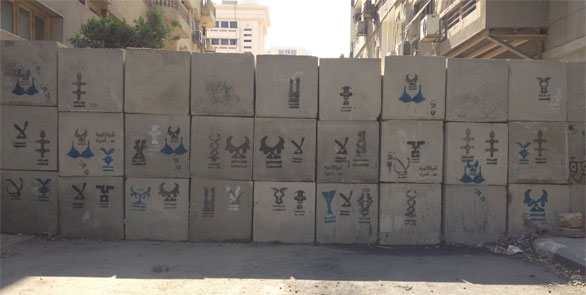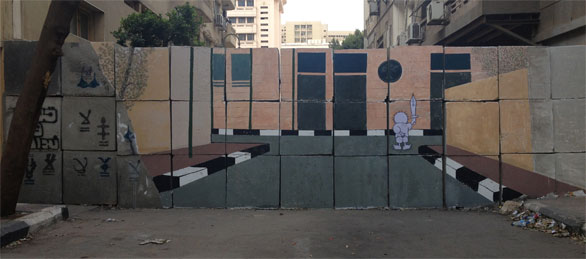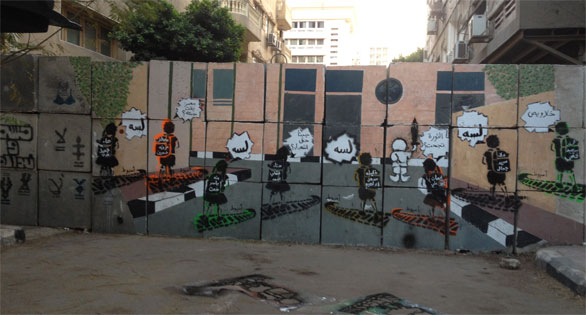
Bahia Shehab’s latest work on the streets of Cairo memorialize 51 children killed in a school bus crash. In this image, three brothers have a conversation. Child 1: “They still didn’t get the lesson.” Child 2: “NO.” Child 3: “It’s OK, repetition is the best teacher.”
On November 17, 2012, in a village in Assuit-Egypt, a train crashed into a school bus killing 51 children. These kinds of accidents have always been brushed aside as random acts of chance. The minister of transportation resigned as a result, and the families of the children were compensated financially. There was a huge public outcry … but eventually these children were forgotten.
But the details of this accident that circulated on social networks were still very vivid in my mind. A video of a regretful father who, when asked the last thing he said to his son before he got on the bus, cried bitterly and said that he hit his son so that he would not miss the bus. Another video showed a girl, only nine years of age — one of the survivors — saying calmly on TV to the government, “You are all dogs.” A note circulated commenting on the price paid by the government to each family and comparing it to other more expensive items, like an iPhone or the front light of a Mercedes Benz. The image of the children wrapped in their shrouds. The cries of the mothers who lost 2 or 3 or 4 children in that accident — one of them has been admitted to a psychiatric ward. And finally a list of the dead children’s names.

In this image, the girl says: “I went to heaven and they are all going to hell.” It’s on the burnt building of the ex-ruling National Party in Downtown Cairo.
All the other details were very painful to me, but the list of names just locked the deal in my head. I wanted to paint these children. To me these children were killed by a corrupt system of governance. We started a revolution so that accidents like this would not happen again. I wanted to bring the children back to life.
I collected the names of the children and grouped them into boys, girls and families. I wanted to paint the sisters and brothers who died together — so that they could come to life again on the streets of Cairo, together. I painted each child walking on a train railway. They are painted in black but their wishes and dreams are painted in color.

This girl says: “I wish I grew up to be a princess.” The green plate reads: “Land owned by Princess Nora al-Saud, Giza-Cairo.”
On the 25th of January, 2013, I started painting the children of Assuit on the walls of Cairo. Some of them appear alone to ask a question, like “ I wish I grew up to be a princess” or “ I could have grown up to be a policeman or a scientist.” A sister calms her brother with a lullaby near a bus stop. The lullaby reads, “Mother is on the way” and her brother asks her, “Soon?” A little girl states that she has died and gone to heaven but they (meaning the responsible ones) are all going to hell. But my favorite is on a barrier wall in downtown Cairo. I painted 8 children playing hide and seek.
Child 1: Khalawees (Are you done? Did you hide?)
Child 2: Not yet.
Child 3: Has the revolution succeeded?
Child 4: Not yet.
Child 5: Did we get the rights of the martyrs?
Child 6: Not yet.
Child 7: Has Egypt become heaven on Earth?
Child 8: Not yet.

The first wall Shehab sprayed in front of the Ministry of Interior, with her series “A thousand times No.”
This barrier wall has a very special story for me. It was the first wall I ever covered with my “A thousand times No” series on February 15, 2012. Another group of artists came on March 15 and painted the street perspective with a very special character, Hanzala, added to the wall as part of a campaign called “There are no walls.” The artists painted the street and pretended that there was no wall — they danced and they sang.

This same wall, painted by other artists to look as if it weren’t there.
When I came back on January 25, even though artists pretended that there was no wall, the walls were still there. So I decided to add the children with Hanzala, with their questions and their dreams.
The children of Assuit will keep appearing on the streets of Cairo, as the conscience of an ongoing revolution, so that we all remember why we went down to the streets and why are we still going down to the streets until today.

In dialogue with the other artists, who put only Hanzala on the street, Shehab painted eight children on the wall.
Comments (2)
Pingback: Wizmo Blog » Blog Archive » An ode to 51 lost children: Fellows Friday with Bahia Shehab